Swedish house prices surging!
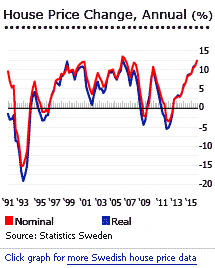 Sweden’s housing market continues to accelerate, fuelled by very low interest rates and a shortage of housing supply. The nationwide house price index surged 10.64% (10.1% inflation-adjusted) in 2015 compared to the previous year, higher than the rise of 6.86% in 2014 (6.64% inflation-adjusted), based on figures from Statistics Sweden - and the highest growth since 2007. House prices increased 2.4% (2.2% inflation-adjusted) in Q4 2015.
Sweden’s housing market continues to accelerate, fuelled by very low interest rates and a shortage of housing supply. The nationwide house price index surged 10.64% (10.1% inflation-adjusted) in 2015 compared to the previous year, higher than the rise of 6.86% in 2014 (6.64% inflation-adjusted), based on figures from Statistics Sweden - and the highest growth since 2007. House prices increased 2.4% (2.2% inflation-adjusted) in Q4 2015.
During 2015:
- Greater Stockholm house prices rose by 13.6% (13.05% inflation-adjusted)
- Greater Göteborg house prices increased by 11.76% (11.22% inflation-adjusted)
- Greater Malmo house prices rose by 9% (8.47% inflation-adjusted)
Of the eight Riksområden (National Areas), RIKS1 Stockholm registered the biggest y-o-y increase of 13.7% (13.14% inflation-adjusted) in 2015, followed by RIKS8 Upper Norrland (13.58%) and RIKS2 Eastern Central Sweden (10.96%), RIKS7 Central Norrland (10.48%), and RIKS5 West Sweden (10.03%). Over the same period, strong house price increases were also seen in RIKS6 Northern Central Sweden (9.07%), RIKS3 Småland with the islands (7.69%), and RIKS4 South Sweden (6.5%).
Demand is rising, but only slightly. Home sales rose 1.17% in 2015, to 55,528 units, according to Statistics Sweden, a slowdown from average annual growth of 5.3% during the previous two years.
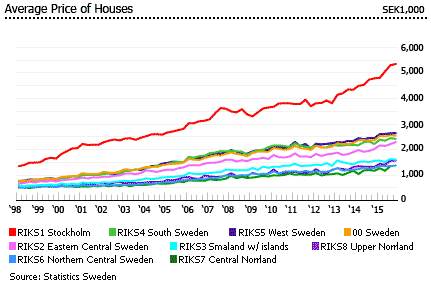
During 2015, the Swedish economy expanded strongly by 4.1%, up from annual growth rates of 2.3% in 2014 and 1.3% in 2013 and from a y-o-y contraction of 0.3%. The economy is expected to grow by 3.2% this year and by 2.9% next year, according to the European Commission.
The outlook for Sweden’s housing market is, however, mixed. House prices are expected to continue rising this year, amidst robust economic growth and ultra-low interest rates, according to local property experts. However, the Swedish central bank (the Sveriges Riksbank) and other economists are concerned that Sweden is now in an unsustainable property bubble that is ready to explode anytime.
Housing bubble risks
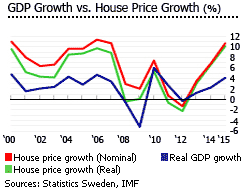
“Valuations on both the asset markets and the housing market in particular are unusually high at present," noted the Riksbank. "This means that the probability of a fall in prices is elevated. Together with increasing indebtedness in the household sector, this has made households, the financial institutions and the financial system as a whole more vulnerable. In the event of a serious economic shock, the consequences for the Swedish economy could be great.”
Agreed HSBC economist James Pomeroy: “The housing market continues to pose significant risks for the Swedish economy. "With prices now up 18% on the year and no sign of macroprudential measures coming into force, we worry that this is not sustainable.
“Should the housing market roll over at any point in 2016 (or 2017) the impact on the economy would be severe. Estimates from the National Institute of Economic Research suggest that a 20% fall in house prices would lead to a recession-like impact on consumption and unemployment, with a smaller fall still having severe economic consequences,” added Pomeroy.
Yet even though the Riksbank itself worries that Sweden may be in an unsustainable housing bubble, the Riksbank continues to slash its policy rate, now at -0.5%, driving up house prices further by making money cheap to borrow.
From one boom to the next
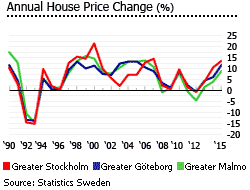
Sweden’s present house price boom started in mid-1990s, after the recovery from a financial crisis caused by a previous housing boom. From 1996 to 2007, the Greater Stockholm house price index soared 217% (119% inflation-adjusted). House prices rose 236% (185% inflation-adjusted) in Greater Malmo, and 202% (156% inflation-adjusted) in Greater Gothenburg. In five of Sweden’s eight regions, house prices doubled.
The boom was set off by low interest rates, rapid economic growth and lack of new supply. With inflation stabilizing after 1995, interest rates for house purchases dropped from more than 10% during the first half of 1996, to less than 5% between 2004 and 2008.
There was a pause in 2008, when the average price of houses in Sweden (one- and two- dwelling buildings) fell 0.9% (-1.7% inflation-adjusted) in the year to end-Q1 2009. In Greater Stockholm, the average price of houses fell by 5.5% (or -6.3% when adjusted for inflation).
Prices regained momentum in 2009, surging 10.3% y-o-y to Q1 2010 (9.2% inflation-adjusted). Greater Stockholm’s average house price rose 11.4% y-o-y (10.3% inflation-adjusted). Average house prices also increased by 12.5% (11.4% inflation-adjusted) in Greater Goteborg, and by 14.2% (13% inflation-adjusted) in Greater Malmo.
After falling by 1.3% (-1.9% inflation-adjusted) from Q3 2011 to Q3 2012, house prices soared again by 26.7% (26.8% inflation-adjusted) from Q4 2012 to Q4 2015. Likewise, after a contraction of 0.3% in 2012, the economy grew continuously from 2013 to 2015 by an average of 2.6% annually.
By reducing housing supply, free-market reforms helped cause the house price boom
Housing supply in Sweden has been really low, on a par with Europe’s supply laggards such as the Netherlands and the UK.

There was a notable drop in dwellings built for social renting during mid-1990s to early 2000s, because of free-market economic reforms, which strongly reduced total completions:
- Around 42,000 dwellings were built annually from 1980 to 1990.
- From 1995 to 2001, less than 10,000 dwellings were completed annually, largely due to the decline in social building.
- It was only in 2004 that dwelling completions again exceeded 20,000 units. From 2004 to 2009, more than 27,000 dwellings were completed annually.
“We have built around half of what other countries have over the last 20 years. That shows that we have a long-term problem," said Stefan Attefall, Sweden’s Minister for Public Administration and Housing.
The national objective of building 250,000 new homes up to 2020, the present mandate of the Swedish Association of Public Housing Companies (SABO), is clearly insufficient to eliminate Sweden’s housing shortage of 436,000 homes.

In order to increase supply, a government incentive of SEK 3.2 billion (EUR345.04 million) per annum was included in the 2016 Budget to support new rental properties and student housing, i.e., about 15,000 apartments every year, and an additional SEK3.5 billion (EUR380 million) will be allocated to increased housing construction under the Millions Homes Programme.
Despite the recent increase in construction activity, Sweden continues to have one of the lowest housebuilding rates in Europe along with the Netherlands and the UK, according to Housing Europe.
However dwelling starts also rose by 16.3% y-o-y to 41,908 units in 2015, according to Statistics Sweden. This was far higher than the annual average of 14,400 starts from 1994 to 2002, and 23,800 starts from 2007 to 2012. Dwelling starts increased to 30,475 units in 2013 and to 36,045 units in 2014.
Rent controls have damaged housing supply
The recent surge in house prices is partially to be blamed on the country’s low rents, which discourage builders from building dwellings for lease, recently causing developers, analysts and landlords to call for the government to scrap rent regulations.
Swedish law requires that rent-setting be negotiated between tenant organizations and MHCs or private landlord organizations. Private rents are compared to social housing rents, which leads to rent conformity across tenures. This has led to rental yields that are relatively low and uncompetitive.
This rent-setting structure means that in attractive central urban locations, rents are often well below market levels. This limits the profitability of the private rental market, which has therefore declined significantly over the past two decades.
Rents in Sweden increased by an average of 1.7% in 2014, slightly less than the 2.2% growth in 2013. An average three-room apartment can be rented for SEK 6,257 (€ 674.66) per month, according to Statistics Sweden - that is if you can get an apartment, given the shortage. On average, rent makes up about a quarter of people’s income, according to Fastighetsägarna.
“It is almost impossible for immigrants and new arrivals to penetrate this market – it is all about who you know and how much money you have,” says Billy McCormac of Fastighetsägarna property association. Accordingly, there is now a thriving rental black market, with bribes of as much as SEK100,000 per room to get a direct contract.
“Rent controls were supposed to enable people to live in central locations, but now it is having the opposite effect,” adds McCormac.
Every year, rent rises are negotiated between the tenants’ association, representing about 350,000 tenants, and the Stockholm property agency, representing 5,000 private rental companies. Over the past decade, rents have risen by about 19% – not far ahead of inflation, which was about 12%. Rents rose by about 1.12% last year.
Owner occupied homes currently account for 64.7% of all dwellings in Sweden. About 41.6% of which are straightforward owner occupied homes, while 23.2% are tenant-owned cooperative dwellings. The growth of tenant-owned cooperatives has trimmed the rental sector, as new cooperatives have taken over previously rented property, and built new dwellings. These conversions have been prevalent in major cities. Rented dwellings comprised only 35.1% (about 1.56 million units) of all dwellings in 2014 (excluding special housing), down from 35.2% in 2013 and 40.5% in 2000, based on figures from Statistics Sweden.
The debate on the housing market is stuck in a classic left-right divide:
“The regulation creates lock-in effects that make mobility too low and reduce demand for new housing,” says Anders Danielsson, executive vice president at Skanska AB, the country’s largest builder.
In contrast, Marie Linder, head of the tenants union, isn’t convinced that the proposed solution will be an answer to the housing shortfall. Linder believes that there are other measures needed to enhance construction. “We don’t believe changes to the negotiating system like introducing market pricing would increase the number of homes; it would only mean that some people will not be able to stay in their homes,” said Linder.
Tax reforms also have encouraged home-ownership
Recent reforms of property taxation have strongly encouraged home-ownership:
- In 2006, taxes for owner-occupied housing and tenant-ownership associations and their members were reduced - to about half of what would be required for neutrality, vis-à-vis other capital taxes and interest deductibility.
- In 2007, the tax on imputed housing rent was abolished, making ownership preferable to renting (imputed rent is assessed on a rent that is deemed whether the owner actually rented the unit out or not).
- In 2008, the real estate tax was replaced by a municipal fee of SEK4,500 (€485). On the other hand, the capital gains tax was raised from 20% to 30%.
These reforms have been part of a shift to the right in Swedish politics.
Swedish politics was dominated by the Swedish Social Democratic Party for 60 years after the Great Depression. It won between 40%-55% of the votes in all elections between 1930 and 1990.
But a centre-right government led by the aristocrat Carl Bildt was elected in 1991-1994, after weak economic growth during the 1970s and 1980s tarnished the image of the Social Democrats.
It was with a changed psychology and a commitment to budget cuts that the Swedish Social Democratic Party returned to power under Ingvar Carlsson (1994-1996) and then under Göran Persson (1996-2006).
In September 2006 the economic pain inflicted by Perrson’s government caused the victory of right-wing Moderate Party. Its leader Fredrik Reinfeldt and the conservatives held power from 2006 to 2014.
In October 2014, the Swedish Social Democratic Party under Stevan Löfven again returned to power in coalition with the Green Party, albeit in a hung parliament, having won only 31% of the popular vote. Löfven promised that he would seek wide support for his plans to boost welfare, schools and jobs.
Interest rates are at historic lows
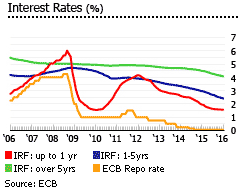
In February 2016, the Riksbank cut its policy rate to -0.5%, after many previous rate cuts. The central bank also bought SEK 30 billion (€ 3.2 billion) worth of nominal government bonds with maturities of up to 25 years, to “support the upturn in inflation and ensure that long-term inflation expectations are in line with the inflation target”. Purchases of government bonds will continue for the first half of 2016.
Mortgage interest rates also followed central bank rates down. In January 2016:
- The average interest rate for housing loans with a maturity of up to 1 year dropped to 1.57%, from 1.95% a year ago.
- For loans with maturity of over 1 year and up to 5 years, the average interest rate fell to 2.41%, from 2.96% a year ago.
- For loans with maturity of over 5 years, the average interest rate fell to 4.09%, to 4.49% a year ago.
Record low borrowing costs have caused a surge in housing loans to households, which rose 8.32% in 2015 to €2.7 trillion, up from €2.5 trillion in the previous year. In the past 14 years housing lending to households has soared 219.7%.
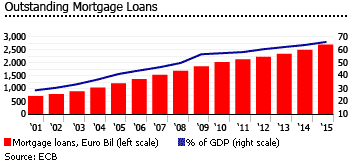
As interest rates have fallen, more people have chosen variable rate loans. About 68% of new loans were variable rate, while 23.5% were short-term fixed, and only 8.5% medium to long-term fixed. Of all outstanding loans around 55.6% are now variable rate, up from 45.9% in Q4 2012, according to the European Mortgage Federation (EMF).
Sweden’s economic growth has beaten expectations

In Q4 2015, the Swedish economy grew by 4.5% from a year earlier, far higher than the 3% growth forested by the central bank and the strongest pace in nearly five years, based on official statistics. During 2015, the economy expanded by 4.1%, up from annual growth rates of 2.3% in 2014 and 1.3% in 2013 and from a y-o-y contraction of 0.3%.
“Everything looks very good,” said Roger Josefsson of Danske Bank. “It’s a strong number and it’s welcome that exports were so strong as exports have been missing in the economic recovery since the financial crisis.”
This strong growth was mainly due to a surge in domestic demand caused by Riksbank’s record stimulus, in an effort to defend its inflation target of 2%. Moreover, the government’s efforts to accommodate the influx of immigrants from war-torn countries like Syria and Iraq are boosting public spending and economic growth. In addition, exports were strengthened by the fact that during the past three years, the Swedish krona (SEK) depreciated against the euro by almost 13%.
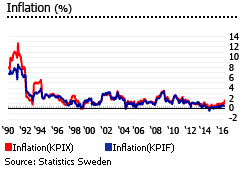
The economy is expected to expand further by 3.2% this year and by 2.9% next year, according to the European Commission .
The country’s budget deficit was around 1% of GDP in 2015, down from 1.7% of GDP in 2014, mainly due to rising tax income, according to the European Commission . The deficit is expected to increase slightly to 1.1% of GDP in 2016 and 1.2% of GDP in 2017.
Gross public debt stood at 44% of GDP last year, down slightly from 44.9% of GDP in 2014. The gross public debt is expected to fall to 43.1% in 2016 and to 42.3% in 2017.
Unemployment stood at 7.1% in December 2015, down from 7.8% in the same period last year. The jobless rate is expected to fall to 6.9% this year, and to 6.7% in 2017.
Consumer prices in Sweden rose by an annualized 1.6% in January 2016, an improvement from 0.6% in the same month last year, according to Statistics Sweden. Inflation is expected to be 1.1% this year and 1.7% in 2017, according to the European Commission.